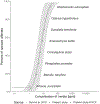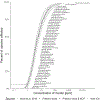Comparative Toxicity of Oil Spill Herding Agents to Aquatic Species
- PMID: 35156233
- PMCID: PMC11474249
- DOI: 10.1002/etc.5310
Comparative Toxicity of Oil Spill Herding Agents to Aquatic Species
Abstract
Chemical herding agents are surfactant mixtures used to coalesce spilled oil and increase slick thickness to facilitate mechanical recovery or in situ burning. Only two herders are currently listed on the United States' National Oil and Hazardous Substances Pollution Contingency Plan or National Contingency Plan product schedule for potential use in spill response: the surface collecting agents Siltech OP-40™ and ThickSlick 6535™. Toxicity data for spill response agents are frequently available only for two estuarine species, mysid shrimp (Americamysis bahia) and inland silversides (Menidia beryllina), and are particularly limited for herding agents. Toxicity can vary over several orders of magnitude across product type and species, even within specific categories of spill response agents. Seven aquatic species were tested with both Siltech OP-40™ and ThickSlick 6535™ to evaluate acute herder toxicity and relative species sensitivity. The toxicity assessment included: acute tests with A. bahia and M. beryllina, the freshwater crustacean Ceriodaphina dubia, and the freshwater fish Pimephales promelas; development of the echinoderm Arbacia unctulate; and growth of a freshwater alga Raphidocelis subcapitata and marine alga Dunaliella tertiolecta. Siltech acute toxicity values ranged from 1.1 to 32.8 ppm. ThickSlick acute toxicity values ranged from 2.2 to 126.4 ppm. The results of present study show greater toxicity of Siltech compared to ThickSlick with estimated acute hazard concentrations intended to provide 95% species protection of 1.1 and 3.6 ppm, respectively, on empirical data and 0.64 and 3.3 ppm, respectively, with the addition of interspecies correlation data. The present study provides a greater understanding of species sensitivity of these two oil spill response agents. Environ Toxicol Chem 2022;41:1311-1318. © 2022 SETAC. This article has been contributed to by U.S. Government employees and their work is in the public domain in the USA.
Keywords: Herder; Oil spill; Species sensitivity distribution; Surface collecting agent; Toxicity.
© 2022 SETAC. This article has been contributed to by U.S. Government employees and their work is in the public domain in the USA.
Conflict of interest statement
Figures




References
-
- Aggarwal S, Schnabel W, Buist I, Garron J, Bullock R, Perkins R, Potter S, & Cooper D (2017). Aerial application of herding agents to advance in-situ burning for oil spill response in the Arctic: A pilot study. Cold Regions Science and Technology, 135, 97–104. 10.1016/j.coldregions.2016.12.010 - DOI
-
- Australian and New Zealand Environment and Conservation Council. (2000). Australian and New Zealand guidelines for fresh and marine water quality (pp. 1–103). Australian and New Zealand Environment and Conservation Council and Agriculture and Resource Management Council of Australia and New Zealand.
Publication types
MeSH terms
Substances
Grants and funding
LinkOut - more resources
Full Text Sources
Medical
Miscellaneous

